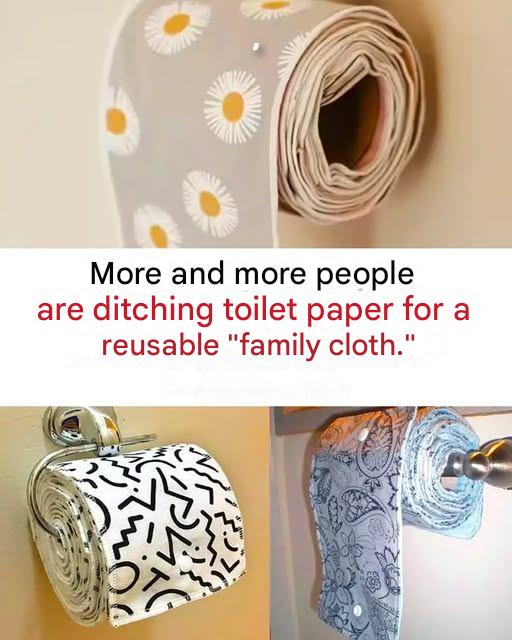ADVERTISEMENT
Why More People Are Ditching Toilet Paper in Favor of Reusable ‘Family Wipes’
In recent years, a growing number of people have started to rethink their bathroom habits, specifically when it comes to toilet paper. Amid increasing environmental concerns and a shift towards sustainability, many are choosing to ditch traditional toilet paper in favor of a more eco-friendly alternative: reusable “family wipes.” While this may sound unconventional to some, this movement is gaining momentum as people become more conscious of their environmental footprint and look for practical, sustainable solutions for everyday life.
In this article, we’ll dive into why family wipes are becoming increasingly popular, how they work, and the benefits they offer for both your family and the planet.
What Are Family Wipes?
Family wipes, often referred to as “reusable toilet wipes,” are cloth wipes designed for personal hygiene. These wipes are typically made from soft, absorbent materials like cotton or bamboo, which are gentle on the skin while offering the same level of cleanliness as toilet paper. Unlike disposable wipes or traditional toilet paper, family wipes are washable and reusable, making them an eco-friendly alternative.
While these wipes can be used in the same way as toilet paper, they require a little extra care. After each use, they are stored in a designated container, washed, and reused. This system drastically reduces waste while still providing the hygiene benefits of traditional toilet paper.
Why Are People Making the Switch?
1. Environmental Benefits
One of the biggest driving forces behind the switch to family wipes is the desire to reduce environmental impact. Traditional toilet paper production involves cutting down trees, consuming vast amounts of water, and using energy-intensive processes. In contrast, reusable family wipes significantly reduce paper waste. By switching to cloth, you’re not contributing to deforestation or excessive energy consumption, and you’ll save countless rolls of toilet paper from entering landfills.
Additionally, many family wipes are made from eco-friendly materials such as bamboo or organic cotton, which are renewable resources. Bamboo, for example, grows quickly and requires little water compared to traditional tree-based paper products.
2. Cost Savings
While the initial cost of purchasing family wipes might be higher than buying a few rolls of toilet paper, the long-term savings are substantial. A single set of high-quality reusable wipes can last for months or even years, drastically reducing the need for continual toilet paper purchases. Over time, these wipes can save you money while contributing to a more sustainable household.
3. Healthier and Softer on Skin
Family wipes are typically made from softer, natural fabrics that are gentle on the skin, which can be especially beneficial for those with sensitive skin or conditions like hemorrhoids. Unlike toilet paper, which can sometimes cause irritation, cloth wipes are gentle and soothing, providing a more comfortable option for personal hygiene.
4. Reduced Risk of Plumbing Issues
Many disposable wipes, even those labeled as “flushable,” can cause blockages in plumbing systems and damage to sewage infrastructure. Family wipes, being reusable and not flushed down the toilet, eliminate this risk entirely. This helps to prevent clogged pipes and expensive plumbing repairs.
How Do Family Wipes Work?
1. The Setup
To begin using family wipes, you’ll need to create a system that works for your household. This typically involves:
- A storage container for used wipes (which can be a wet bag or a lidded container with a seal to contain odors).
- A place to store clean wipes (either folded and stacked in a basket or in a special wipe dispenser).
- A plan for washing the wipes regularly (either by hand or in the washing machine).
Many people set up a “clean wipe station” near their toilet or in a bathroom drawer for easy access. After use, the wipe is placed into the storage container, where it remains until it’s time for washing.
2. The Cleaning Process
After use, the wipes are stored until laundry day. You can wash family wipes in your washing machine, using a regular detergent, and air-dry them or use a dryer on low heat. Some people prefer to pre-soak them in a natural disinfectant or a mild solution of vinegar and water before washing to keep them fresh and clean.
It’s recommended to wash family wipes after every use or at least every 2–3 days to maintain cleanliness and prevent odors. You’ll also want to wash the wipes in a hot water cycle to ensure proper sanitization.
How to Use Family Wipes in Your Daily Routine
Here’s a simple guide on how to incorporate family wipes into your daily bathroom routine:
For Complete Cooking STEPS Please Head On Over To Next Page Or Open button (>) and don’t forget to SHARE with your Facebook friends
